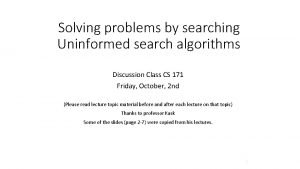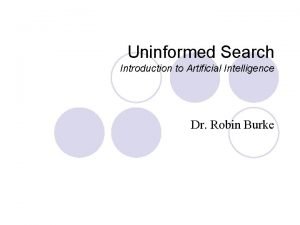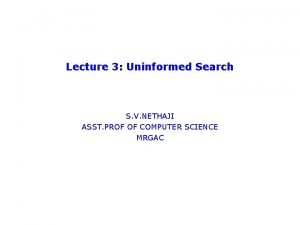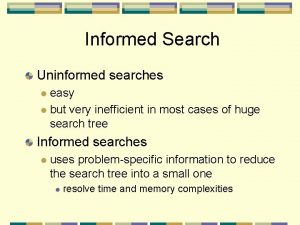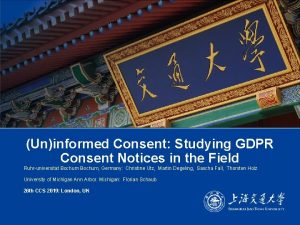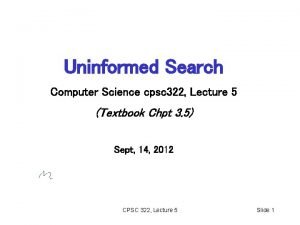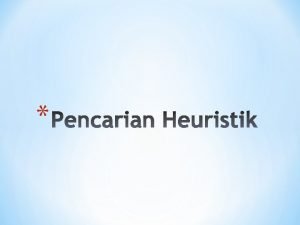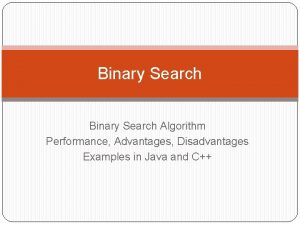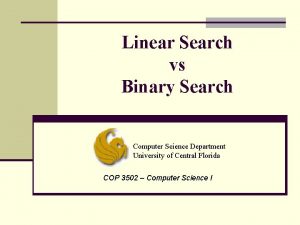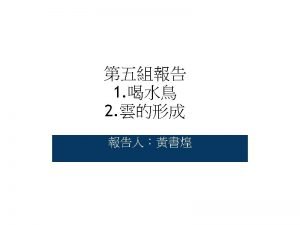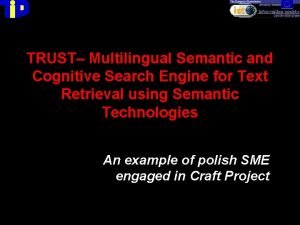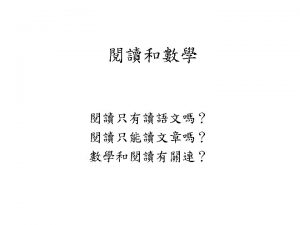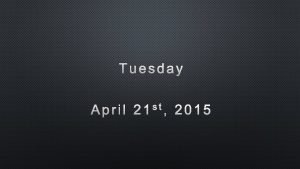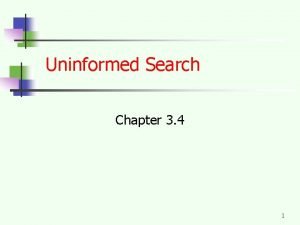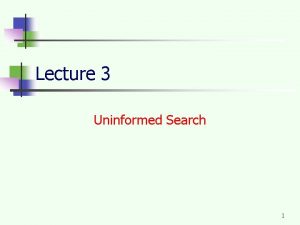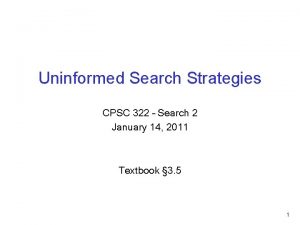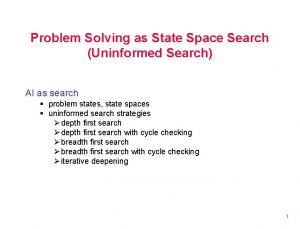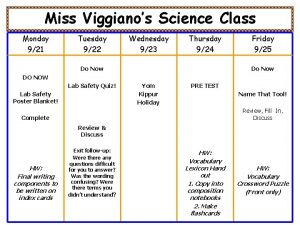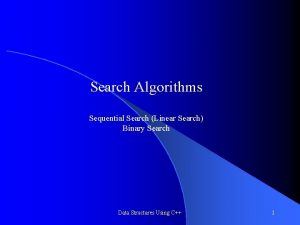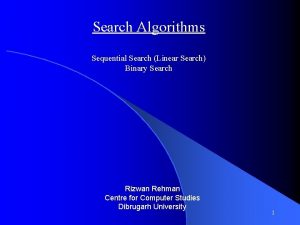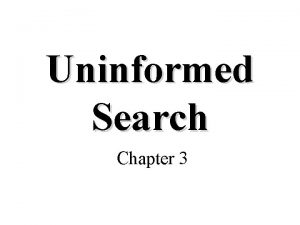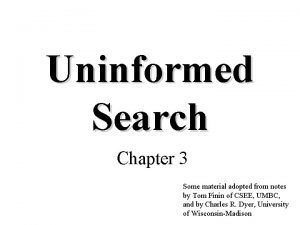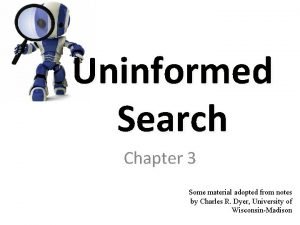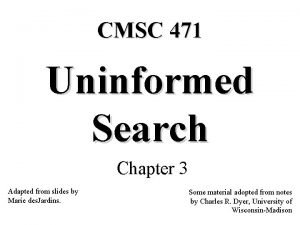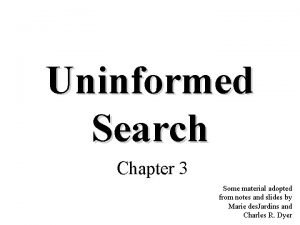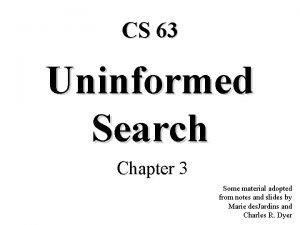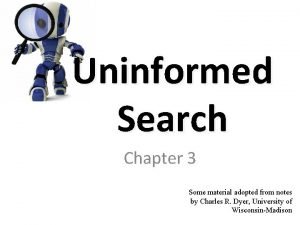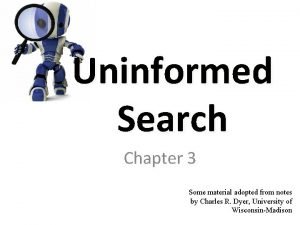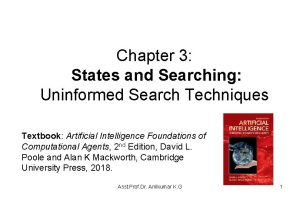Uninformed Search Reading Chapter 4 Tuesday 921 Uninformed

































- Slides: 33

Uninformed Search Reading: Chapter 4 (Tuesday, 9/21)

Uninformed l Search through the space of possible solutions l Use no knowledge about which path is likely to be best l Exception: uniform cost • Each path is given a cost 2

Characteristics l Before actually doing something to solve a puzzle, an intelligent agent explores possibilities “in its head” • Human vs. rational? • For what games, do we do this? l l l Search = “mental exploration of possibilities” Making a good decision requires exploring several possibilities Execute the solution once it’s found 3

Formulating Problems as Search Given an initial state and a goal, find the sequence of actions leading through a sequence of states to the final goal state. Terms: • • • Successor function: given action and state, returns {action, successors} State space: the set of all states reachable from the initial state Path: a sequence of states connected by actions Goal test: is a given state the goal state? Path cost: function assigning a numeric cost to each path Solution: a path from initial state to goal state 4

Example: the 8 -puzzle l How would you use AI techniques to solve the 8 -puzzle problem? 5

8 -puzzle URLS l http: //www. permadi. com/java/puzzle 8 l http: //www. cs. rmit. edu. au/AI-Search/Product 6

8 Puzzle l States: integer locations of tiles l Action: left, right, up, down Goal test: is current state = (0 1 2 3 4 5 6 7 8)? Path cost: same for all paths Successor function: given {up, (5 2 3 0 1 8 4 7 6)} -> ? What would the state space be for this problem? l l • (0 1 2 3 4 5 6 7 8) • (0 1 2)(3 4 5) (6 7 8) 7

What are we searching? l State space vs. search space • State represents a physical configuration • Search space represents a tree/graph of possible solutions… an abstract configuration l Nodes l Expand • Abstract data structure in search space • Parent, children, depth, path cost, associated state • A function that given a node, creates all children nodes, using successsor function 8

9

Uninformed Search Strategies The strategy gives the order in which the search space is searched l l l Breadth first Depth limited search Iterative deepening Uniform cost 10

Algorithm for Breadth-first 11

12

13

14

15

Visualization 16

Algorithm for depth-first search 17

18

19

20

21

22

23

24

25

Complexity Analysis l l Completeness: is the algorithm guaranteed to find a solution when there is one? Optimality: Does the strategy find the optimal solution? Time: How long does it take to find a solution? Space: How much memory is needed to perform the search? 26

Cost variables l Time: number of nodes generated Space: maximum number of nodes stored in memory Branching factor: b l Depth: d l Path length: m l l • Maximum number of successors of any node • Depth of shallowest goal node • Maximum length of any path in the state space 27

Complexity BFS vs. DFS l Optimal? l Time = l Space = l Complete? 28

Can we combine benefits of both? l Depth limited • Select some limit in depth to explore the problem using DFS • How do we select the limit? l Iterative deepening • DFS with depth 1 • DFS with depth 2 up to depth d 29

30

31

32

Three types of incompleteness l Sensorless problems l Contingency problems l Exploration problems • Adversarial problems 33
 Nfpa 921 fire causes classifications
Nfpa 921 fire causes classifications What is informed search and uninformed search
What is informed search and uninformed search Blind search algorithm example
Blind search algorithm example Bfs uninformed search
Bfs uninformed search Uninformed search in artificial intelligence
Uninformed search in artificial intelligence Comparison of uninformed search strategies
Comparison of uninformed search strategies Uninformed search
Uninformed search Uninformed and informed search
Uninformed and informed search Pre reading while reading and post reading activities
Pre reading while reading and post reading activities Tuesdays with morrie chapter 1
Tuesdays with morrie chapter 1 Uninformed optimism curve
Uninformed optimism curve If you don't read the newspaper you're uninformed
If you don't read the newspaper you're uninformed Uninformed consent
Uninformed consent Uninformed optimism
Uninformed optimism Dfs complexity
Dfs complexity Unified search vs federated search
Unified search vs federated search Local search vs global search
Local search vs global search Federated search vs distributed search
Federated search vs distributed search Https://images.search.yahoo.com
Https://images.search.yahoo.com Best first search is a type of informed search which uses
Best first search is a type of informed search which uses Blind search dan heuristic search
Blind search dan heuristic search Video.search.yahoo.com
Video.search.yahoo.com Twvideos
Twvideos Benefits of binary search
Benefits of binary search Search by image
Search by image Http://search.yahoo.com/search?ei=utf-8
Http://search.yahoo.com/search?ei=utf-8 Cognitive search engine
Cognitive search engine Yahoo
Yahoo Monday tuesday wednesday thursday friday calendar
Monday tuesday wednesday thursday friday calendar Tuesday please
Tuesday please Saturday morning prayer
Saturday morning prayer Shrove tuesday significato
Shrove tuesday significato Tuesday morning prayers
Tuesday morning prayers Tuesday morning prayer gif
Tuesday morning prayer gif



